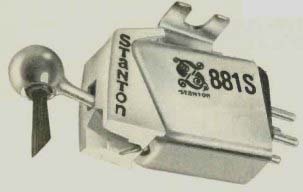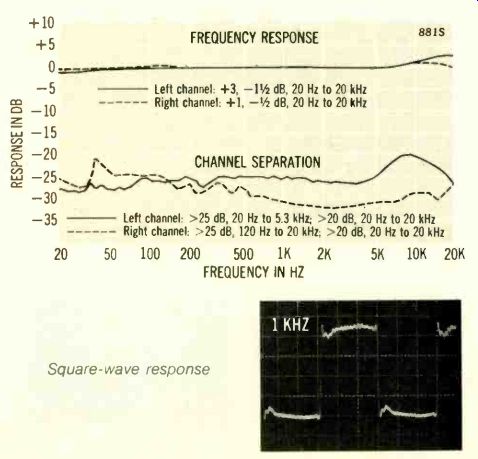
Stanton Calibrates a New Leader
The Equipment:
Stanton Model 881S Professional Calibration Standard stereo phono pickup, with Stereohedron stylus and brush.
Price: $150.
Warranty: "full," one year parts and labor.
Manufacturer: Stanton Magnetics, Inc., Terminal Drive, Plainview, N.Y. 11803.
Comment: Ideally, the stylus used to play a record should be identical in shape to the one used in cutting the master from which the disc was made. The problem with this approach is, of course, that such a stylus would cut the groove anew every time the record is played and cause very rapid wear indeed. So here-as elsewhere in audio--compromise is necessary.
General practice has been to make the contact area be tween stylus and vinyl as small as possible in the direction of groove travel (so as to trace the groove accurately with out gouging it) and as long as possible from top to bottom (to provide the largest possible bearing surface and minimize wear). This was the direction taken first by the elliptical stylus, then the Shibata, and then by the Stereohedron, introduced by Stanton's sister company Pickering specifically for playing stereo discs. Stanton has, partly through skillful use of electron microscopy, developed an improved Stereohedron for the 881S.
While this pickup is capable of tracking the "torture test," administered by the CBS Technology Center, at a vertical tracking force of 6.5 milli-newtons (0.65 gram), the manufacturer's preferred setting is 10 milli-newtons (1 gram). With this VTF, the 881S performs very well in the maximum tracking level tests, although not quite as well as the 681EEE that preceded it at the top of Stanton's Calibration line. Second harmonic distortion is (like that of the 681EEE) better than average. The newer pickup has less spurious second harmonic at high frequencies, and this, despite slightly higher IM, seems to make it somewhat smoother-sounding than its predecessor.
With its recommended load of 47,000 ohms in parallel with 275 picofarads, the new Stanton has a frequency response that remains within 1/2 dB of perfect flatness be tween 100 Hz and 6 kHz. Across that range the channel separation is 25 dB or better, with the match between channels within 1/2 dB. Below 100 Hz the response falls off a trifle, reaching -1 dB at 20 Hz while maintaining the same standard of channel matching. Above 6 kHz each channel begins to show a mild peak, that in the left reaching + 2 1/2 dB at 20 kHz and that in the right + 1 dB at about 12.5 kHz before returning to 0 dB at 20 kHz. Generally the 881S has slightly better separation than the 681EEE and a somewhat more extended-and well controlled-high end.
At 1.33 millivolts per centimeter per second, the output is on the high side for a top-of-the-line pickup. Compliance, as shown by a resonant frequency of 8.4 Hz in an SME 3009 arm, is moderately high; since this frequency is a bit on the low side, the pickup should be happier with a some what less massive arm. Vertical tracking angle measures 25 degrees, distinctly higher than the nominal standard of 15 degrees.
Microscopic examination confirms that the stylus has a large contact area and that its finish and alignment are very good. Square-wave response shows virtually no over shoot, mild undershoot, and heavily damped ultrasonic ringing.

----------FREQUENCY RESPONSE
----------Square-wave response
In the past, we sometimes had experienced difficulties with the type of dust brush that comes integrally mounted on the 881S. This time, after we set it up according to directions, the brush-equipped cartridge did very well in tracking our favorite warped, thin-stock disc. Stanton claims that the brush actually adds damping to the cartridge/arm system and hence helps in tracking warped records: on the basis of our experience with the 881S we can see no ground for arguing the point.
Records heard via the Stanton sound bright, clear, and detailed, with an especially smooth high end. Sharp, quick transients such as those found on direct-cut discs from Telarc, Sheffield, and Umbrella are taken in stride and reproduced with a stunning sense of presence. The stereo image is vivid, plausible, and stable. In the short time that we have known the pickup it has become one of our favorites.
If our elation concerning the 881S collides with any aspect of its reality, it is the price, which begins to approach the realm of imported moving-coil exotica. The Stanton is certainly competitive in this league, however, and we would expect its sound to tempt many a music lover into parting with the required cash. For those in whom parsimony vies with aesthetic sensibility, the large contact area of the Stereohedron stylus offers, in addition, low record wear and the ability to salvage worthy sonics from some well-worn discs. And professional (and semipro) users will doubtless find the individual calibration that accompanies each unit useful. Over-all, it sounds like a good deal to us.
-------------
(High Fidelity, Nov. 1977)
Also see:
Stanton 681EEE phono cartridge (Equip. Reports, Jul. 1977)
Philips AH-572 stereo preamplifier (Equip. Report, Nov. 1977)
Pioneer PL-570 turntable (Equip. Report, Nov. 1977)
Hitachi SR-903 receiver (Equip. Report, Apr. 1977)
Empire 698 turntable (Equip. Profile, Apr. 1977)
Sony STR-5800SD stereo FM/AM receiver (Equip. Report, Nov. 1977)
ADC--Accutrac turntable (ad, Apr. 1977)